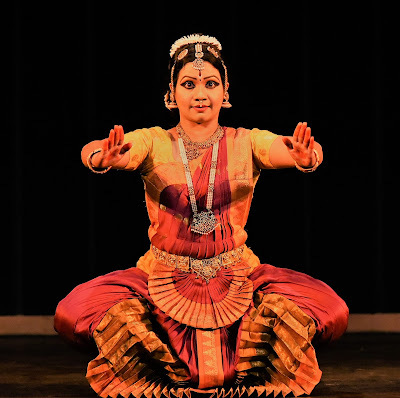Good dancing, poor turnout
 |
| Geeta Sirisha (Pic: Anoop Arora) |
The environs were laden with the yuletide spirit and the winter chill. The flowers in the lawns were blooming – chrysanthemums, dahlias and genda. There was a huge Christmas tree right in the centre of the space in front of the auditorium. All this lifted my spirits and with quick steps, I walked towards the auditorium. This was on the 22nd of December 2017, and Geeta Sirisha was dancing at the IHC. As I walked in, however, what a disappointment it was. There were very few people initially, about 10-12, who were sitting in the auditorium. Manjariji from The Hindu, who was there, went backstage to boost Sirisha’s morale, who had come down from Bengaluru that very morning. I felt really ashamed. This is not expected of Delhi, which is known as a hub of classical performances. A young dancer has been called from another city to perform at a very prestigious platform — whose responsibility does it become to give her proper publicity and a decent audience? At times, we have been to performances where the Stein auditorium is full and people outside are squabbling for entry. And yet this young dancer performed her entire repertoire to an almost empty house, and still gave it her 100%. This has happened earlier, but not in such poor numbers. Some art activist should awaken the media and the organizers from their slumber. I on my part will list a young dancer’s performance on my blog as soon as I come to know of it, and request as many people to take time out and watch it.
 |
| Pic: Anoop Arora |
Coming back to Sirisha’s performance, it was titled Shringara: Shades of Love. Love is the ultimate emotion, and the rasas evoked by love are sambhog shringara, vatsalya shringara and bhakti shringara. Sambhog shringara is between a nayak and a nayika.
 |
| Pic: Anoop Arora |
Sirisha began the performance with a pushpanjali and an alarippu in nine beats, an ode to Lord Ganesha. He is addressed as the Maheshwar putra, vighna vinayak, depicted through elephant ears and trunk. This was followed by nritta, footwork, eye movements and neck movements at a good pace. The second piece was a varnam, ‘Neelamegha shyamsundara’ in raag Mallika, taal aditalam. Radha is waiting for her lord and pining. She pleads to him to come to her as she wants to listen to his flute. She tells a parrot to go to her lord and relate to him her agony. Then she addresses the lotus in the Yamuna to carry her beating heart to the blue lord and hand it to him. Even a second of separation is intolerable. He was the one who brought the parijata the moment Satyabhama asked for it, and He was the one who did the tulabhara, showing the world the power of Rukmini’s devotion. In the depiction, the nayika converses with the parrot, telling him that he can recognize her beloved as the neelamegha shyamsundaram. The abhinaya of the parrot was very expressive, and Sirisha has eyes which can express a lot. The nritta was powerful and agile, with leaps, squats and footwork. Every jathi had a different technique. The coy nayika reminisces about the kiss during raas leela, and the navarasa that Madana Mohana embodies. He is the epitome of beauty — aravind nayan shrivenugopal Krishna, with the morpankha on his head, the flute in his hand, and his lotus feet. In the depiction of the tulabhara, Sirisha depicted how Krishna is weighed and balanced by a single tulsidal by Rukmini. As Radha prepares her chambers with flowers in anticipation of his coming, she tells the parrot to go away. Impressive abhinaya and precise nritta.
 |
| Pic: Anoop Arora |
The next composition was an ashtapadi by Jayadevji, ‘Yahi Madhav yahi Keshav’, in which Radha is waiting for Krishna. He comes in the morning, showing all signs of a dalliance with another woman. She tells him to go away. He had shown no mercy to Putana, who had come to feed him. Again, an abhinaya piece done effectively.
 |
| Pic: Anoop Arora |
Following this was a padam which depicted a dialogue between a husband and a wife. The husband suspects his wife to be cheating on him. She explains to him that his ears have been poisoned by other women, and she truly remains his wife. She tries desperately to make him believe, and then leaves it to his dharma whether he should believe his wife or not. This was in raag Kapi, roopak taal. This was an old padam and Sirisha looked every bit a housewife, drawing alpana, offering her husband a drink and paan. She wants to be kissed and when in dismay, gets annoyed. She depicted the argument between the two effectively.
 |
| Pic: Anoop Arora |
The thillana was in raag Desh, aditalam. It celebrated the spirit of love which unites all, its bhava and samvedna. The nritta was well-rendered with versatile footwork. Sirisha is a good dancer, with a very bright future, but sadly, the thillana was attended by just three people. The choreography was mostly her own, except for one piece which was choreographed by Bragha Bessell.
Sirisha has trained under Shri K.R.S. Prasanna and the Kirans of Bengaluru, and is a graded artist in Doordarshan.
 |
| Pic: Anoop Arora |


Comments
Post a Comment